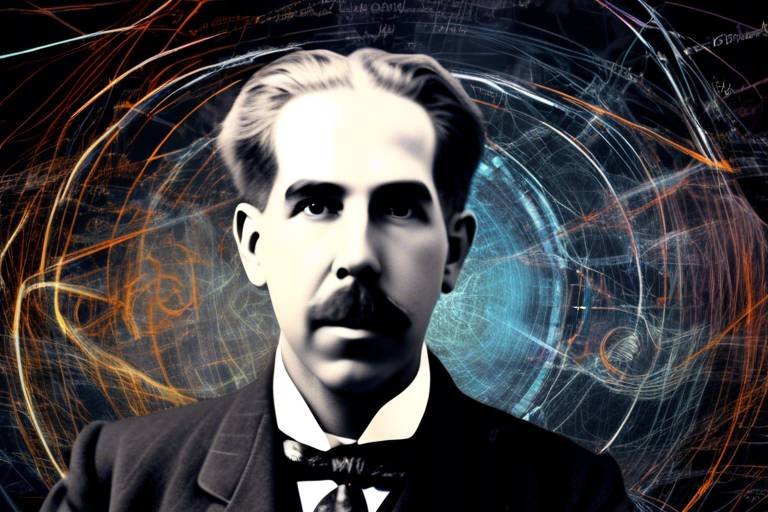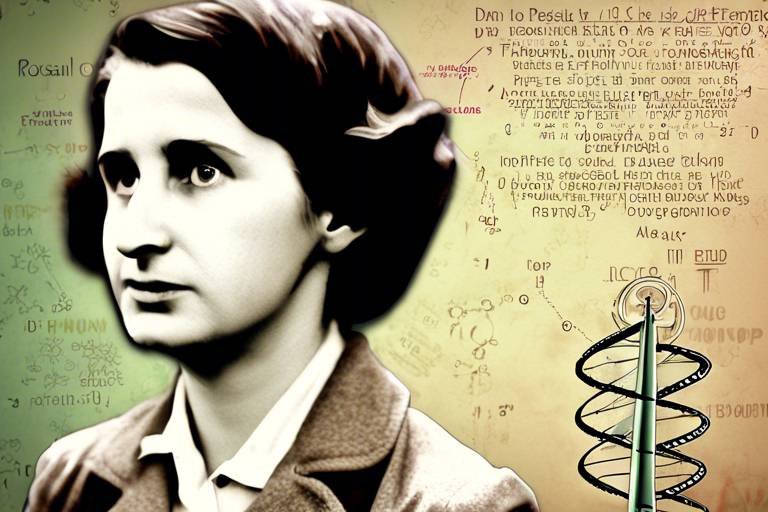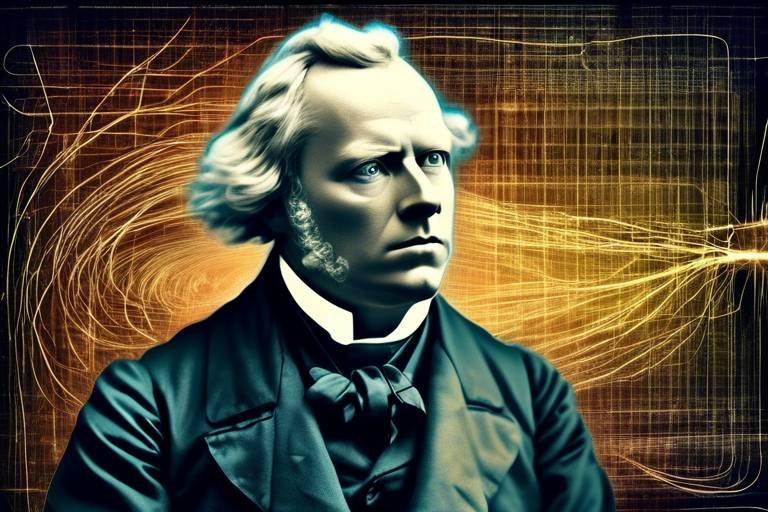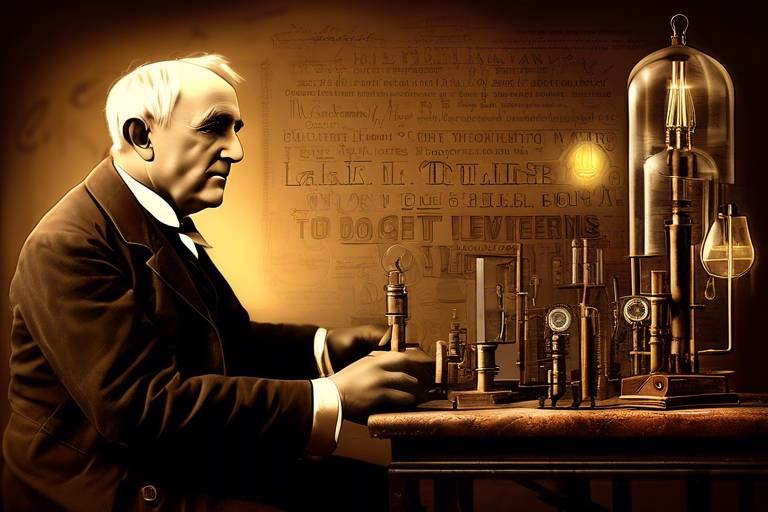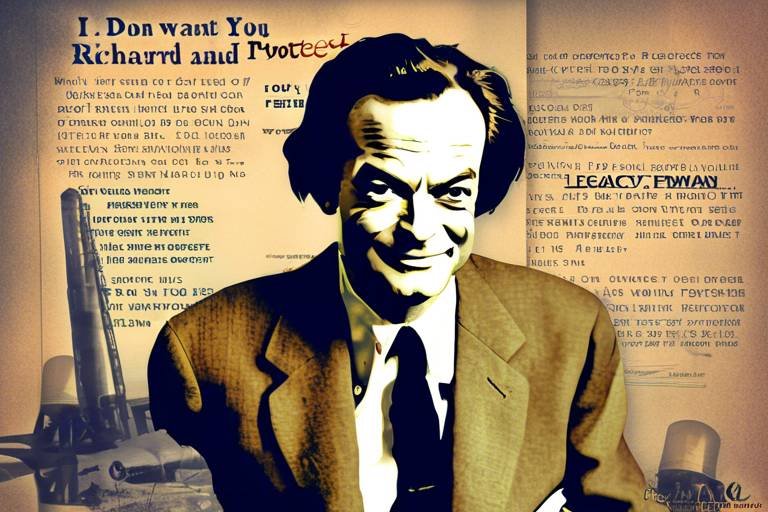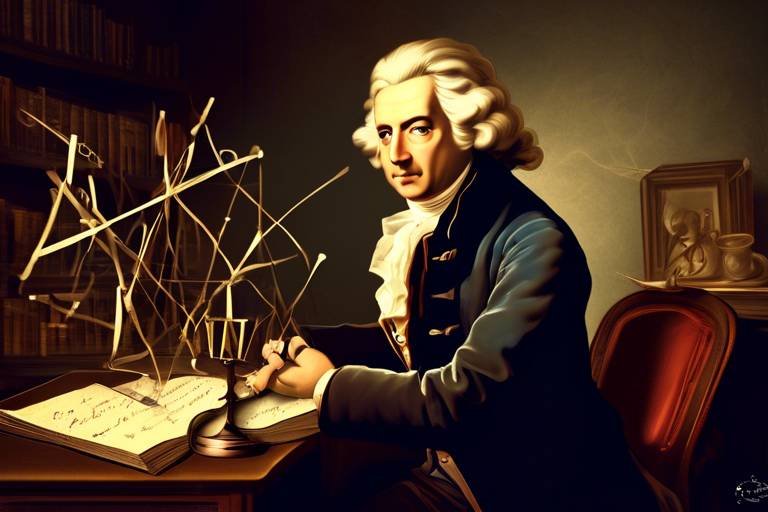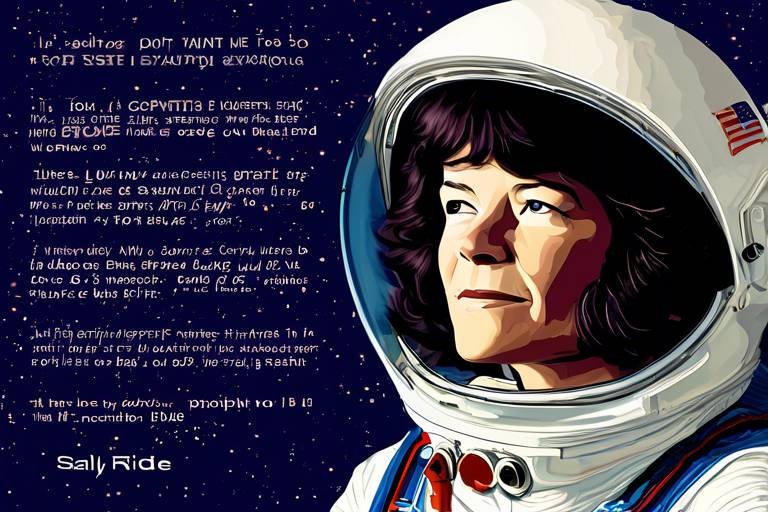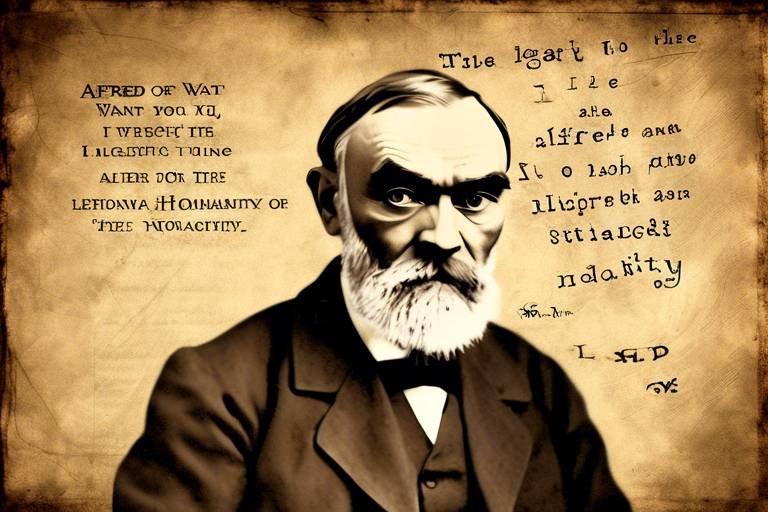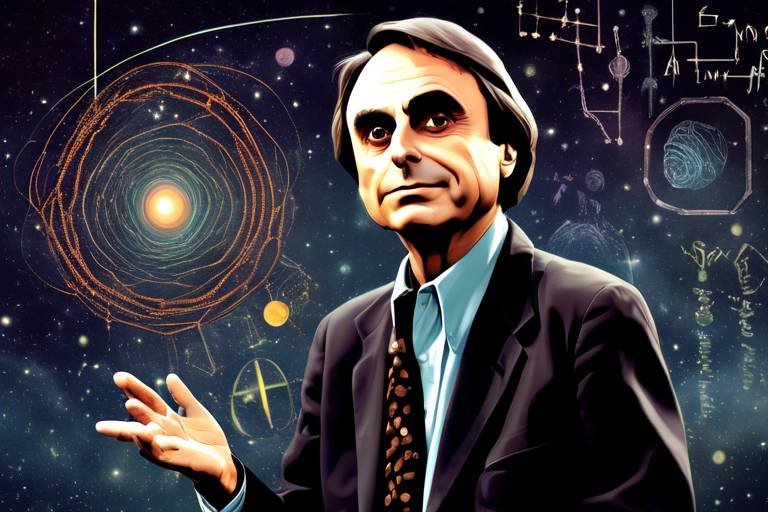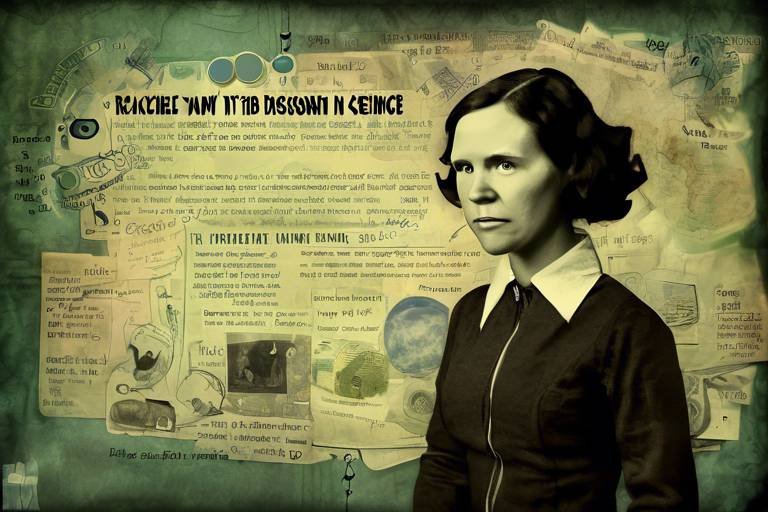The Groundbreaking Work of Niels Bohr in Quantum Mechanics
Niels Bohr, a name that resonates with the very foundations of modern physics, revolutionized our understanding of atomic structure and the behavior of matter at the quantum level. His groundbreaking work in the early 20th century not only reshaped the scientific landscape but also ignited a spark of curiosity that continues to fuel research and discovery today. Imagine standing at the edge of a vast ocean, where every wave represents a new idea, a new possibility—this was the realm Bohr ventured into, and his contributions have had a ripple effect that reaches far and wide.
Born in 1885 in Copenhagen, Denmark, Bohr's journey into the world of physics began at a time when classical mechanics was the reigning paradigm. However, as he delved deeper into the mysteries of the atom, he realized that the existing theories were inadequate to explain the complexities he encountered. In 1913, he introduced his famous atomic model, which proposed that electrons orbit the nucleus in specific, quantized energy levels. This was a radical departure from the previous notion of electrons spiraling into the nucleus, akin to planets revolving around the sun. Bohr's model not only provided a more stable picture of atomic structure but also set the stage for the development of quantum mechanics as we know it today.
But what makes Bohr's contributions truly remarkable is not just the introduction of new theories; it's the way he challenged the very fabric of classical physics. His principle of complementarity, for instance, posits that objects can exhibit both particle-like and wave-like behavior depending on how they are observed. This duality is not just a quirky characteristic of particles like electrons; it fundamentally alters our understanding of reality itself. It's as if the universe is playing a game of hide-and-seek, revealing different aspects of itself based on the questions we ask.
To illustrate this concept, consider the famous double-slit experiment. When light passes through two closely spaced slits, it creates an interference pattern on a screen behind, suggesting that light behaves like a wave. However, if we try to measure which slit the light particle (photon) goes through, it behaves like a particle instead. This perplexing behavior illustrates the heart of wave-particle duality and reinforces Bohr's theories, forcing us to rethink our assumptions about the nature of reality.
As we explore Bohr's contributions, we must also acknowledge the profound implications of his work. The concept of wave-particle duality has not only influenced our understanding of quantum mechanics but has also paved the way for future research that continues to unravel the mysteries of the microscopic world. It challenges us to ask deeper questions about the universe and our place within it, pushing the boundaries of what we know.
Furthermore, Bohr's correspondence principle offers a bridge between quantum mechanics and classical physics, asserting that quantum phenomena must align with classical predictions as we approach large quantum numbers. This principle serves as a critical link, ensuring that the new theories do not completely discard the established ones but rather expand upon them, much like adding new chapters to a well-loved book.
In summary, Niels Bohr's groundbreaking work in quantum mechanics has left an indelible mark on the field of physics. His innovative ideas and theories have not only transformed our understanding of atoms and subatomic particles but have also inspired generations of scientists to explore the unknown. As we continue to delve into the realms of quantum mechanics, we carry forward the legacy of Bohr, a legacy that encourages us to question, to explore, and to marvel at the intricate dance of particles that make up our universe.
- What is Niels Bohr best known for?
Niels Bohr is best known for his contributions to the understanding of atomic structure and quantum mechanics, particularly his atomic model and the principle of complementarity.
- How did Bohr's work influence modern physics?
Bohr's work laid the foundation for future developments in quantum theory, influencing other prominent physicists and shaping the course of modern physics.
- What is wave-particle duality?
Wave-particle duality is the concept that particles like electrons can exhibit both wave-like and particle-like properties, depending on how they are observed.

Bohr's Atomic Model
Niels Bohr's atomic model, introduced in 1913, was nothing short of revolutionary. Before Bohr, the prevailing models of the atom were largely insufficient in explaining the stability of atoms and the spectral lines observed in hydrogen. Bohr proposed a groundbreaking idea: that electrons orbit the nucleus in specific, quantized energy levels, rather than in arbitrary paths. This was a radical shift from the classical view of atomic structure, which treated electrons as particles moving in any trajectory around the nucleus.
Imagine a solar system, where the sun represents the nucleus and the planets symbolize the electrons. In Bohr's model, these planets can only exist in certain orbits—much like how electrons can only occupy certain energy levels. If an electron gains energy, it can jump to a higher orbit, but it must release that energy to return to its original level. This concept of quantization was a game-changer, as it explained why atoms emitted light at specific wavelengths, leading to the distinct spectral lines we observe in atomic spectra.
Bohr's model can be summarized in a few key points:
- Quantized Orbits: Electrons exist in fixed orbits with quantized energy levels.
- Energy Absorption and Emission: Electrons can absorb or emit energy to transition between these orbits.
- Stability of Atoms: This model provided a logical explanation for atomic stability, which classical physics could not.
To illustrate Bohr's atomic model further, let’s take a look at a simple table that outlines the key features of his theory:
| Feature | Description |
|---|---|
| Energy Levels | Electrons occupy discrete energy levels around the nucleus. |
| Quantization | Electrons can only exist in certain allowed orbits. |
| Photon Emission | When electrons transition between orbits, they emit or absorb photons. |
Bohr's model laid the groundwork for future developments in atomic theory. It not only provided a better understanding of atomic structure but also sparked further research into the behavior of subatomic particles. Although later advancements, such as quantum mechanics, expanded on Bohr's ideas, his atomic model remains a cornerstone of modern physics. It serves as a reminder of how a single idea can transform our understanding of the universe.

The Principle of Complementarity
Niels Bohr's principle of complementarity is one of the cornerstones of quantum mechanics, and it fundamentally reshaped our understanding of the microscopic world. This principle asserts that objects, such as electrons and photons, can exhibit both particle-like and wave-like behavior, but not simultaneously. Imagine trying to take a picture of a chameleon; depending on the background, it may appear green or brown, but you can't capture both colors at once. Similarly, in quantum mechanics, the behavior of particles changes based on how we choose to observe them.
Bohr proposed that the outcome of an experiment depends on the experimental setup, which challenges the classical notion that objects have definite properties regardless of observation. For instance, when we conduct an experiment to measure the position of an electron, we might find it behaving like a particle. However, if we set up an experiment to measure its wave properties, it can behave like a wave, demonstrating interference patterns. This duality is not just a quirky trait of quantum objects; it's a fundamental aspect of their nature.
To illustrate this concept further, consider the famous double-slit experiment. When particles like electrons are fired through two slits, they create an interference pattern on a screen behind the slits, indicating wave-like behavior. However, if we try to measure which slit the electron passes through, the interference pattern disappears, and we observe particle-like behavior instead. This experiment beautifully encapsulates Bohr's principle of complementarity, showing that the act of measurement itself influences the outcome.
The implications of this principle are profound. It suggests that our understanding of reality is not as straightforward as we might like to believe. Instead, it opens up a realm of possibilities where different aspects of a single entity can coexist, depending on how we choose to look at it. Bohr's principle of complementarity not only challenges the traditional views of physics but also encourages a more holistic approach to understanding the universe.
In practical terms, the principle has led to the development of various technologies, including quantum computing and quantum cryptography, which rely on the unique properties of quantum states. As we delve deeper into the world of quantum mechanics, Bohr's insights continue to guide researchers and physicists, reminding us that the universe is far more complex and intriguing than meets the eye.
- What is the principle of complementarity?
The principle of complementarity, proposed by Niels Bohr, states that objects can exhibit particle-like or wave-like behavior depending on the experimental setup, but not both at the same time.
- How does the double-slit experiment illustrate this principle?
The double-slit experiment shows that when particles like electrons are not observed, they create an interference pattern (wave-like behavior). However, when observed, they behave like particles, demonstrating the principle of complementarity.
- Why is the principle of complementarity important?
This principle challenges classical physics and has significant implications for our understanding of quantum mechanics, influencing technologies such as quantum computing and cryptography.

Wave-Particle Duality
The concept of is one of the most fascinating and mind-bending ideas in quantum mechanics, and it has its roots firmly planted in Niels Bohr's groundbreaking work. Imagine for a moment that light, which we often think of as a beam of particles called photons, can also behave like a wave, spreading out and interfering with itself. This duality isn't just a quirky characteristic of light; it extends to matter itself, including the tiny electrons that zip around the nucleus of an atom.
Bohr's insights into wave-particle duality challenged our classical intuitions. In the classical world, we categorize objects based on their characteristics: a ball is a particle, while sound waves are, well, waves. However, in the quantum realm, particles like electrons can exhibit properties of both particles and waves depending on how we observe them. This is where things get really interesting. When we conduct experiments, the behavior of these particles can change based on the setup. If we measure an electron's position, it behaves like a particle. But if we don't measure it in that way, it can spread out and behave like a wave.
To illustrate this, consider the famous double-slit experiment. When electrons are fired at a barrier with two slits, and we don't observe which slit they go through, they create an interference pattern on a screen behind the barrier, much like waves do. However, if we set up a measurement to determine which slit the electron passes through, the interference pattern disappears, and the electrons behave like particles. This peculiar behavior raises a multitude of questions about the nature of reality itself. Are particles merely waves of probability until we observe them? What does it mean to "observe" something in the quantum world?
The implications of wave-particle duality go beyond mere curiosity; they are foundational to our understanding of the universe. This duality suggests that the classical distinctions we make in the macroscopic world break down at the quantum level. It has profound implications for fields like quantum computing, quantum cryptography, and even our philosophical understanding of reality. As scientists continue to explore these phenomena, they are not just uncovering the secrets of the quantum world but also challenging our very perceptions of existence.
In summary, wave-particle duality is not just a scientific curiosity; it is a window into the complex and often counterintuitive nature of the universe. It invites us to reconsider our assumptions and embrace the mystery that lies at the heart of quantum mechanics. As we delve deeper into this realm, we find ourselves grappling with questions that challenge the boundaries of human understanding.
- What is wave-particle duality? Wave-particle duality is the concept that particles, such as electrons and photons, can exhibit properties of both waves and particles depending on the experimental conditions.
- How does the double-slit experiment demonstrate wave-particle duality? In the double-slit experiment, electrons create an interference pattern when not observed, behaving like waves. However, when observed, they behave like particles, showing that measurement affects their behavior.
- What are the implications of wave-particle duality? Wave-particle duality challenges classical physics and has significant implications for quantum mechanics, influencing technologies like quantum computing and our understanding of reality.

Experiments Supporting Duality
When we dive into the world of quantum mechanics, one of the most mind-bending concepts we encounter is wave-particle duality. This principle suggests that particles, like electrons and photons, can exhibit properties of both waves and particles depending on how we observe them. But how do we know this isn't just a wild theory? The answer lies in groundbreaking experiments that have consistently supported this dual nature.
One of the most famous experiments demonstrating wave-particle duality is the double-slit experiment. Imagine this: you have a barrier with two slits and a source of particles (like photons) shooting towards it. When both slits are open, something astonishing happens. Instead of simply creating two distinct lines on a screen behind the barrier, the particles create an interference pattern—a series of alternating light and dark bands. This pattern is characteristic of waves, suggesting that the particles are behaving like waves as they pass through both slits simultaneously.
But here’s where it gets even more intriguing: if we place a detector at one of the slits to observe which slit the particle goes through, the interference pattern disappears! Instead, we see two distinct lines, indicating that the particles behaved like classical particles rather than waves. This observation leads us to a perplexing question: does merely observing a particle change its behavior? It seems that the act of measurement collapses the wave function, forcing the particle to choose a definite state.
This experiment isn't just a one-off; it has been replicated countless times with various particles, including electrons and even larger molecules like fullerenes. Each time, the results reinforce the idea that particles can exist in a state of superposition—acting as both waves and particles—until measured. The implications of these findings are profound, reshaping our understanding of reality itself.
To further illustrate the concept of wave-particle duality, we can look at a simple table summarizing key experiments and their findings:
| Experiment | Key Findings |
|---|---|
| Double-Slit Experiment | Demonstrated interference patterns, indicating wave-like behavior; collapse of pattern upon measurement. |
| Photoelectric Effect | Showed that light can behave like particles (photons), with energy quantized in discrete packets. |
| Compton Scattering | Confirmed that photons can collide with electrons, exhibiting particle-like properties and momentum transfer. |
These experiments collectively challenge our classical intuition about the nature of light and matter. They reveal a universe where particles can dance between states, embodying both the wave and particle characteristics. This duality not only highlights the complexity of quantum mechanics but also opens the door to a deeper understanding of the fundamental workings of our universe.
So, the next time you ponder the mysteries of the quantum world, remember the double-slit experiment and its companions. They serve as a reminder that in the realm of the very small, reality is often stranger than fiction, and the act of observation itself plays a crucial role in shaping the nature of existence.
- What is wave-particle duality? Wave-particle duality is the concept that particles, such as electrons and photons, can exhibit both wave-like and particle-like properties depending on how they are observed.
- What is the double-slit experiment? The double-slit experiment is a famous physics experiment that demonstrates wave-particle duality by showing that particles can create interference patterns when not observed, but behave like particles when measured.
- Why does observation affect particle behavior? In quantum mechanics, the act of measurement can collapse a particle's wave function, forcing it to take on a definite state, which changes its behavior.

Implications for Quantum Theory
The implications of wave-particle duality, as proposed by Niels Bohr, are nothing short of revolutionary in the realm of quantum mechanics. This concept reshaped our understanding of the microscopic world, introducing a level of complexity that classical physics simply could not accommodate. Imagine trying to fit a square peg into a round hole; that's what classical physics faced when confronted with the peculiar behaviors of subatomic particles. Bohr's work provided the tools to navigate these challenges, allowing scientists to explore the dual nature of light and matter.
One of the most profound implications is the realization that particles do not have definite properties until they are measured. This notion contradicts classical intuitions, where objects have well-defined states regardless of observation. In quantum mechanics, the act of measurement plays a crucial role, essentially collapsing a particle’s wave function into a specific state. This phenomenon leads to the famous thought experiment known as Schrödinger's cat, which illustrates the paradoxes inherent in quantum theory. Until observed, the cat is both alive and dead, highlighting the bizarre nature of quantum reality.
Furthermore, Bohr's wave-particle duality has paved the way for numerous technological advancements. For instance, the development of quantum computing relies heavily on these principles. By leveraging the dual nature of particles, quantum computers can perform calculations at unprecedented speeds, revolutionizing fields such as cryptography, material science, and artificial intelligence. The implications extend beyond theoretical physics; they touch on practical applications that could reshape our everyday lives.
To better understand the impact of Bohr's contributions, let’s break down some of the key implications:
- Quantum Superposition: Particles can exist in multiple states simultaneously, leading to complex behaviors that challenge our perceptions of reality.
- Uncertainty Principle: Formulated by Heisenberg, this principle states that certain pairs of physical properties cannot be simultaneously known to arbitrary precision, further complicating our understanding of particle behavior.
- Quantum Entanglement: Bohr’s ideas laid the groundwork for understanding entangled particles, which remain connected regardless of distance, defying classical intuitions about separateness.
In summary, the implications of Bohr's wave-particle duality resonate throughout the fabric of modern physics. They challenge our fundamental concepts of reality and have opened up new avenues of research and technology that were once unimaginable. As we continue to explore the quantum realm, Bohr's insights remind us that the universe is far more intricate and fascinating than we could ever have anticipated.
- What is wave-particle duality? Wave-particle duality is the concept that every particle or quantum entity can be described as either a particle or a wave, depending on the experimental conditions.
- How did Niels Bohr contribute to quantum mechanics? Niels Bohr introduced the atomic model that described electrons in discrete energy levels and formulated the principle of complementarity, which states that objects can exhibit particle-like or wave-like behavior.
- What are the practical applications of quantum mechanics? Quantum mechanics has led to numerous advancements, including the development of quantum computing, lasers, and various technologies in telecommunications and medicine.

Bohr's Correspondence Principle
Niels Bohr's correspondence principle is one of those brilliant ideas that, at first glance, might seem simple but packs a powerful punch in the realm of physics. Introduced in the early 20th century, this principle essentially states that the predictions of quantum mechanics must align with those of classical physics when dealing with systems that have a large quantum number. Imagine it as a bridge connecting two worlds—one governed by the familiar laws of classical physics and the other by the peculiar rules of quantum mechanics.
Let’s break this down a bit. In classical physics, we’re used to thinking about objects in a straightforward manner. For instance, a baseball follows a predictable trajectory when thrown. However, in the quantum realm, particles like electrons behave in ways that can seem utterly bizarre. They can exist in multiple states at once, and their behaviors can differ dramatically based on how we observe them. Bohr’s correspondence principle assures us that when we look at systems large enough—like a baseball—the quantum peculiarities fade away, and we can rely on the classical laws we know and love.
This principle not only provides a crucial link between the two domains of physics, but it also serves as a guideline for physicists. It helps them understand that while quantum mechanics can seem like a wild ride, it doesn’t completely discard the foundations laid by classical physics. Instead, it builds upon them, showing that both realms can coexist and complement each other. This is particularly important when developing theories that apply to both small particles and larger systems.
To illustrate this further, consider a simple table that outlines the differences between classical and quantum mechanics:
| Aspect | Classical Mechanics | Quantum Mechanics |
|---|---|---|
| Scale | Macroscopic (large objects) | Microscopic (atoms, subatomic particles) |
| Behavior | Predictable and deterministic | Probabilistic and uncertain |
| Key Principles | Newton's laws, conservation of energy | Wave-particle duality, uncertainty principle |
| Application | Everyday phenomena (e.g., motion of cars) | Atomic and subatomic interactions (e.g., electron behavior) |
As we can see from the table, while classical mechanics applies to the everyday world we experience, quantum mechanics governs the bizarre behaviors of particles at an atomic level. Bohr's correspondence principle acts as a reminder that when we zoom out to larger scales, the strange rules of quantum mechanics start to mirror the predictable behaviors we’re accustomed to.
In conclusion, Bohr's correspondence principle is not merely a theoretical concept; it is a fundamental idea that helps physicists navigate the complex interplay between classical and quantum realms. It reassures us that despite the apparent chaos of the quantum world, there is a coherent structure that aligns with our everyday experience. This principle not only enriches our understanding of physics but also encourages continued exploration and dialogue among scientists as they strive to unravel the mysteries of the universe.
- What is the correspondence principle? The correspondence principle states that quantum mechanics must align with classical physics in the limit of large quantum numbers.
- Why is the correspondence principle important? It bridges the gap between classical and quantum physics, ensuring that quantum predictions converge to classical predictions for larger systems.
- How does the correspondence principle relate to Bohr's work? Bohr introduced this principle as a way to reconcile the behaviors of quantum systems with classical mechanics, highlighting their interconnectedness.

Impact on Quantum Theory Development
Niels Bohr's contributions to quantum mechanics were nothing short of revolutionary, laying a foundation that would shape the trajectory of modern physics. His innovative ideas and theories not only challenged existing paradigms but also opened the door to a plethora of new research avenues. Imagine standing on the edge of a vast ocean of knowledge, where each wave represents a new discovery waiting to be explored. Bohr was that lighthouse guiding physicists through the fog of uncertainty.
One of the most significant impacts Bohr had was on the development of quantum theory itself. His atomic model, which introduced the concept of quantized energy levels, was a game-changer. It was like flipping a switch in a dark room, illuminating our understanding of atomic structure. This model not only explained the stability of atoms but also provided a framework for understanding how atoms interact with light, leading to the development of quantum mechanics as a robust scientific discipline.
Furthermore, Bohr's principle of complementarity challenged the classical view of physics by positing that particles can exhibit both wave-like and particle-like properties. This idea was revolutionary and laid the groundwork for future advancements in quantum theory. It was as if Bohr had handed physicists a new set of glasses, allowing them to see the intricate dance of particles and waves in a way they never could before.
Bohr's influence extended beyond his own theories; he played a crucial role in mentoring and collaborating with other prominent physicists. His interactions with contemporaries such as Werner Heisenberg and Erwin Schrödinger fostered a rich dialogue that propelled quantum mechanics forward. Together, they navigated the complex landscape of quantum theory, each contributing their unique insights. It was a collaborative symphony of ideas that resonated throughout the scientific community.
The **legacy** of Bohr's work is evident in the way modern physics has evolved. His ideas set the stage for future breakthroughs, including the development of quantum field theory and quantum computing. Today, we stand on the shoulders of giants, and Niels Bohr is undoubtedly one of those giants. His contributions have not only enriched our understanding of the microcosm but have also influenced various fields, from chemistry to information technology.
To summarize the profound impact of Bohr on quantum theory development, we can look at the following table:
| Contribution | Description | Impact |
|---|---|---|
| Atomic Model | Introduced quantized energy levels for electrons. | Revolutionized the understanding of atomic structure. |
| Complementarity | Proposed that particles can exhibit both wave and particle properties. | Challenged classical physics and advanced quantum theory. |
| Collaboration | Worked with leading physicists like Heisenberg and Schrödinger. | Fostered dialogue that led to significant theoretical advancements. |
| Legacy | Influenced future research and applications in various fields. | Set the stage for modern physics and technology. |
In conclusion, Niels Bohr's impact on quantum theory development is profound and far-reaching. His innovative ideas and collaborative spirit have left an indelible mark on the field, inspiring generations of physicists to explore the mysteries of the universe. As we continue to delve deeper into the quantum realm, Bohr's legacy serves as a guiding star, illuminating our path toward new discoveries.
- What is Niels Bohr best known for? Bohr is best known for his foundational contributions to quantum mechanics, particularly his atomic model and the principle of complementarity.
- How did Bohr's work influence modern physics? Bohr's work laid the groundwork for future developments in quantum theory and influenced many prominent physicists, shaping the course of modern physics.
- What is wave-particle duality? Wave-particle duality is the concept that particles, such as electrons, can exhibit properties of both waves and particles, a fundamental aspect of quantum mechanics.
- Did Bohr collaborate with other scientists? Yes, Bohr collaborated with many notable scientists, including Albert Einstein and Werner Heisenberg, fostering significant advancements in quantum mechanics.

Collaboration with Other Scientists
Niels Bohr was not just a solitary genius; his revolutionary work in quantum mechanics was significantly shaped by his collaborations with other brilliant minds of his time. These interactions were like a vibrant tapestry, weaving together different ideas and perspectives that ultimately advanced the field of physics. One of the most notable collaborations was with Albert Einstein. Their discussions often revolved around the philosophical implications of quantum mechanics, particularly the nature of reality and the role of observation. While both men respected each other's work, they had fundamental disagreements, especially regarding the interpretation of quantum mechanics.
Another key figure in Bohr's collaborative network was Werner Heisenberg, known for his uncertainty principle. Their exchanges were crucial in developing the concept of complementarity, which posits that objects can exhibit both particle-like and wave-like behaviors. Bohr and Heisenberg's dialogues were not just academic; they were intense and sometimes heated debates that pushed the boundaries of scientific thought. This collaborative spirit was essential in fostering a rich dialogue that propelled quantum mechanics into new territories.
Additionally, Bohr's interactions with other physicists, such as Max Planck and Erwin Schrödinger, further enriched the discourse surrounding quantum theory. Each scientist brought unique insights to the table, creating a collaborative environment that was both competitive and cooperative. For instance, while Schrödinger developed wave mechanics, Bohr was instrumental in integrating these ideas into a broader quantum framework. This synergy among scientists was pivotal in establishing a more cohesive understanding of quantum mechanics.
To illustrate the collaborative landscape of early quantum mechanics, consider the following table that highlights key figures and their contributions:
| Scientist | Key Contribution |
|---|---|
| Albert Einstein | Photoelectric effect and debates on quantum interpretation |
| Werner Heisenberg | Uncertainty principle and complementarity |
| Max Planck | Quantum theory and black-body radiation |
| Erwin Schrödinger | Wave mechanics and the Schrödinger equation |
In summary, Bohr's collaborations were not merely a series of exchanges; they were dynamic interactions that challenged and refined existing theories. His ability to engage with others, debate ideas, and synthesize various viewpoints played a crucial role in shaping modern physics. The collaborative nature of scientific discovery is a reminder that no great idea exists in isolation; rather, it is the product of collective effort and intellectual synergy.
- What was Niels Bohr's main contribution to quantum mechanics?
Bohr's main contribution was the introduction of the atomic model that described electrons orbiting the nucleus in discrete energy levels, along with the principle of complementarity.
- How did Bohr's collaboration with Einstein influence quantum mechanics?
Their debates helped clarify the philosophical implications of quantum mechanics and highlighted the differences between classical and quantum physics.
- What is the significance of the correspondence principle?
The correspondence principle states that quantum mechanics must converge with classical physics as quantum numbers become large, bridging the two realms of physics.

Legacy and Recognition
Niels Bohr's legacy is a tapestry woven with the threads of groundbreaking discoveries and profound insights that have shaped the very foundation of modern physics. His work in quantum mechanics not only revolutionized our understanding of atomic structure but also paved the way for future explorations into the quantum realm. As we delve into the lasting impact of Bohr's contributions, it's essential to recognize the myriad of accolades and honors that have been bestowed upon him, reflecting the high regard in which he is held within the scientific community.
Bohr was awarded the Nobel Prize in Physics in 1922 for his investigation of the structure of atoms and the radiation emanating from them. This prestigious recognition was just the beginning of a long list of accolades that celebrated his contributions. His theories have become a cornerstone of physics, influencing not just theoretical frameworks but also practical applications in various fields, including chemistry and material science.
In addition to the Nobel Prize, Bohr received numerous other honors throughout his illustrious career. Some of the notable awards include:
- Copley Medal (1923) - awarded by the Royal Society of London for outstanding achievements in scientific research.
- Gold Medal of the Royal Astronomical Society (1938) - in recognition of his significant contributions to the understanding of atomic structure.
- Max Planck Medal (1938) - awarded for his work in theoretical physics.
Furthermore, Bohr's legacy extends beyond awards and honors. He played a pivotal role in establishing the Institute for Theoretical Physics in Copenhagen, which became a hub for physicists from around the globe. This institution not only advanced research in quantum mechanics but also facilitated collaboration among scientists, fostering an environment ripe for innovation. His ability to engage in spirited discussions with contemporaries like Albert Einstein and Werner Heisenberg led to the development of new ideas and theories, further solidifying his status as a key figure in the scientific community.
Even today, the influence of Bohr's work can be seen in various scientific disciplines. His principles continue to guide research in quantum physics, and his ideas about atomic structure are foundational in fields ranging from chemistry to materials science. The Bohr model of the atom is still taught in classrooms around the world, serving as a stepping stone for students to grasp more complex concepts in quantum mechanics.
In summary, Niels Bohr's legacy is not merely a collection of awards or accolades; it is a lasting impact that resonates through the corridors of scientific inquiry. His innovative spirit and collaborative nature have left an indelible mark on physics, inspiring generations of scientists to explore the mysteries of the quantum world. As we reflect on his contributions, it becomes clear that Bohr's work will continue to illuminate the path of scientific discovery for years to come.
Here are some common questions regarding Niels Bohr and his contributions to physics:
- What was Niels Bohr's most significant contribution to quantum mechanics?
Bohr's most significant contribution is arguably the Bohr model of the atom, which introduced the idea of quantized energy levels for electrons orbiting the nucleus. - How did Bohr's principle of complementarity influence modern physics?
This principle asserts that objects can exhibit both particle-like and wave-like behavior, challenging classical physics and laying the groundwork for quantum theory. - What is the correspondence principle?
The correspondence principle states that quantum mechanics must align with classical physics in the limit of large quantum numbers, bridging the gap between the two realms.
Frequently Asked Questions
- What is Niels Bohr known for in quantum mechanics?
Niels Bohr is renowned for his groundbreaking contributions to quantum mechanics, particularly his atomic model introduced in 1913. This model revolutionized our understanding of atomic structure by proposing that electrons orbit the nucleus in discrete energy levels, fundamentally altering the way we view atomic stability and behavior.
- What is the principle of complementarity?
The principle of complementarity, formulated by Bohr, states that objects can display either particle-like or wave-like behavior based on the experimental setup. This idea challenged classical physics and was pivotal in laying the groundwork for quantum theory, showcasing the dual nature of light and matter.
- How does wave-particle duality relate to Bohr's work?
Wave-particle duality is a fundamental concept in quantum mechanics that illustrates how particles, such as electrons, can exhibit characteristics of both waves and particles. Bohr's work significantly influenced this concept, as he provided insights that led to experiments, like the double-slit experiment, demonstrating this duality effectively.
- What is the correspondence principle?
The correspondence principle is another key idea introduced by Bohr, which asserts that quantum mechanics should align with classical physics when applied to systems with large quantum numbers. This principle serves as a bridge between quantum and classical physics, ensuring that the two frameworks coexist harmoniously in their respective domains.
- How did Bohr influence future physicists?
Bohr's contributions to quantum theory laid the foundation for many future developments in the field. His work significantly influenced prominent physicists like Werner Heisenberg and Erwin Schrödinger, shaping the course of modern physics and leading to numerous theoretical breakthroughs.
- What was Bohr's approach to collaboration with other scientists?
Bohr was known for his collaborative spirit, engaging in rich dialogues with contemporaries such as Albert Einstein and Heisenberg. These discussions fostered an environment of shared ideas and debate, which advanced the field of quantum mechanics and led to significant theoretical advancements.
- What is Bohr's legacy in modern physics?
Niels Bohr's legacy is profound, with his work continuing to influence modern physics today. He received numerous awards and honors throughout his life, recognizing his pivotal role in the development of quantum mechanics and atomic theory, which remain crucial to our understanding of the universe.

